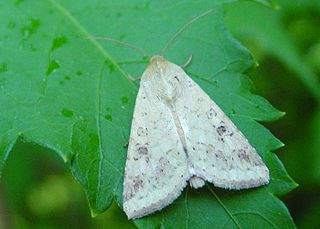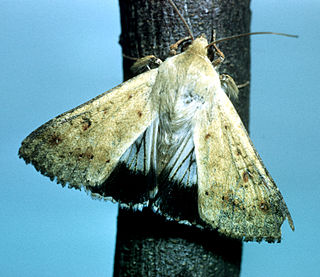
Gossypium is a genus of flowering plants in the tribe Gossypieae of the mallow family, Malvaceae, from which cotton is harvested. It is native to tropical and subtropical regions of the Old and New Worlds. There are about 50 Gossypium species, making it the largest genus in the tribe Gossypieae, and new species continue to be discovered. The name of the genus is derived from the Arabic word goz, which refers to a soft substance.

The Noctuidae, commonly known as owlet moths, cutworms or armyworms, are a family of moths. They are considered the most controversial family in the superfamily Noctuoidea because many of the clades are constantly changing, along with the other families of the Noctuoidea. It was considered the largest family in Lepidoptera for a long time, but after regrouping Lymantriinae, Catocalinae and Calpinae within the family Erebidae, the latter holds this title now. Currently, Noctuidae is the second largest family in Noctuoidea, with about 1,089 genera and 11,772 species. This classification is still contingent, as more changes continue to appear between Noctuidae and Erebidae.

Helicoverpa zea, commonly known as the corn earworm, is a species in the family Noctuidae. The larva of the moth Helicoverpa zea is a major agricultural pest. Since it is polyphagous during the larval stage, the species has been given many different common names, including the cotton bollworm and the tomato fruitworm. It also consumes a wide variety of other crops.

Trichogramma is a genus of minute polyphagous wasps that are endoparasitoids of insect eggs. Trichogramma is one of around 80 genera from the family Trichogrammatidae, with over 200 species worldwide.

Bollworm is the common term for a moth larva that attacks the fruiting bodies of certain crops, especially cotton. The most common moths known as bollworms are:

The pink bollworm is an insect known for being a pest in cotton farming. The adult is a small, thin, gray moth with fringed wings. The larva is a dull white caterpillar with eight pairs of legs with conspicuous pink banding along its dorsum. The larva reaches one half inch in length.

Heliothis is a genus of moths in the family Noctuidae. It was first described by Ferdinand Ochsenheimer in 1816. Some of the species have larvae which are agricultural pests on crop species such as tobacco, cotton, soybean and pigeon pea. Some species originally in this genus have been moved to other genera, see Chloridea and Helicoverpa.

Helicoverpa armigera is a species of Lepidoptera in the family Noctuidae. It is known as the cotton bollworm, corn earworm, Old World (African) bollworm, or scarce bordered straw. The larvae feed on a wide range of plants, including many important cultivated crops. It is a major pest in cotton and one of the most polyphagous and cosmopolitan pest species. It should not be confused with the similarly named larva of the related species Helicoverpa zea.

Helicoverpa is a genus of moths in the family Noctuidae first described by David F. Hardwick in 1965. Some species are among the worst Lepidopteran agricultural pests in the world, and three species migrate long distances both with and without human transportation, mixing resistance alleles along the way.

Helicoverpa punctigera, the native budworm, Australian bollworm or Chloridea marmada, is a species of moth in the family Noctuidae. This species is native to Australia. H. punctigera are capable of long-distance migration from their inland Australian habitat towards coastal regions and are an occasional migrant to New Zealand.

Chloridea virescens, commonly known as the tobacco budworm, is a moth of the family Noctuidae found throughout the eastern and southwestern United States along with parts of Central America and South America.

Heliothinae is a small, cosmopolitan subfamily of moths in the family Noctuidae, with about 400 described species worldwide. It includes a number of economically significant agricultural pest species, such as Helicoverpa armigera and Helicoverpa zea.

Helicoverpa assulta, the oriental tobacco budworm, is a moth of the family Noctuidae. H. assulta adults are migratory and are found all over the Old World Tropics including Asia, Africa, and Australia.

Trigonella suavissima is a herbaceous plant that is endemic to Australia. It is a member of the genus Trigonella and the family Fabaceae. Common names include Cooper clover, Menindee clover, calomba, Darling trigonella, sweet fenugreek, channel clover, sweet-scented clover and Australian shamrock.

Copidosoma is a genus of chalcid wasps, which are parasitoids of Lepidoptera. The wasps are polyembryonic, depositing one or two eggs into their host which then develop into multiple offspring and have a soldier caste and a reproductive caste.

Cajanus scarabaeoides is a flowering plant in the genus Cajanus. Of the 32 different species within the genus Cajanus, only one, C. cajan (pigeonpea), is cultivated. Cajanus scarabaeoides is the closest wild relative to C. cajan, and is one of the easiest wild species to cross with pigeonpea cultivars. C. scarabaeoides is found naturally in both temperate and tropical zones around the globe. This species has higher levels of drought tolerance, is found to have greater protein content, and has higher levels of resistance to insect pests compared to cultivated types. These genetic traits can be crossed with C. cajan to improve the crop's productivity. For subsistence farmers, this can reduce economic losses and drastically improve overall crop yield.

Creontiades dilutus, commonly known as the green mirid, is a member of the bug family Miridae. This insect is considered a "generalist" feeding on over 100 plant species, and is also a major economic pest on several important agricultural crops.
Rhynocoris longifrons is a species of assassin bug in the family Reduviidae. It is a predator of other insects and is found in Asia. Crops on which it is found feeding on pests include pigeon pea, cardamom and peanuts. The insects are potentially useful in biological control because they are more resistant to pesticides than are the pests they consume.

Acanthaspis quinquespinosa is a species of assassin bug found in India, Sri Lanka, Myanmar, Nepal and Tibet. It is a predator, and both nymphs and adults feed on termites, beetles, caterpillars and other insect prey.

Netelia producta is a species of ichneumonid wasp in the subfamily Tryphoninae found in Australia.























